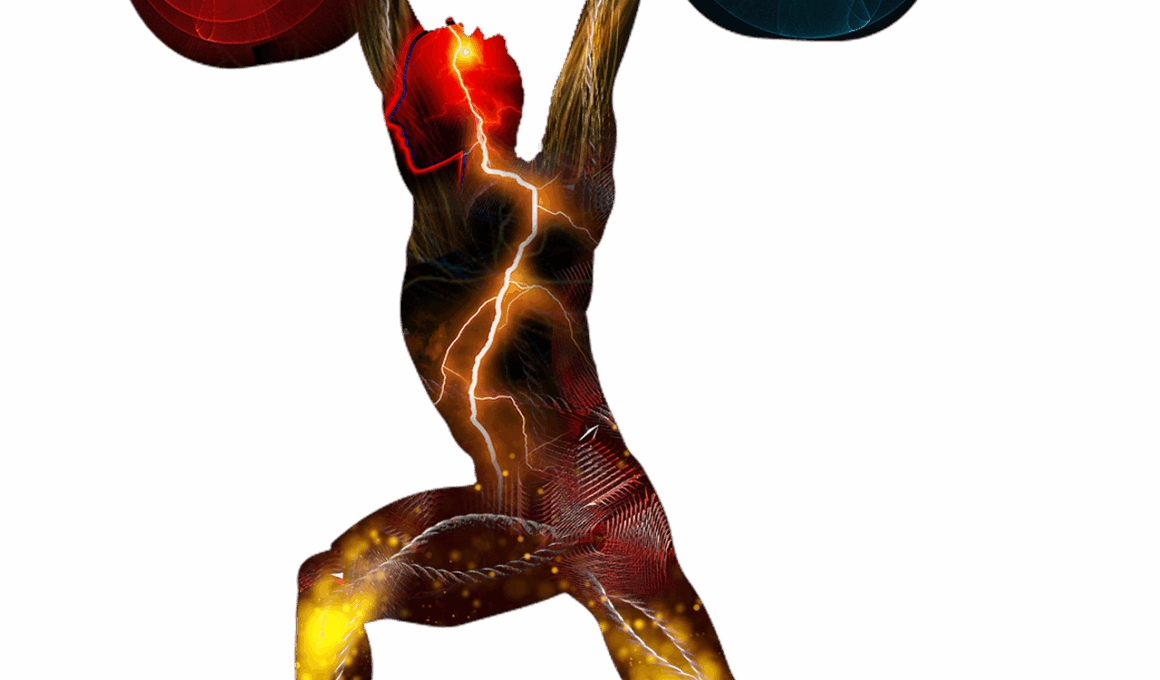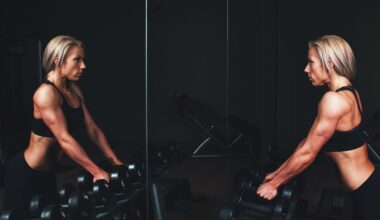Top 10 Olympic Weightlifting Techniques for Strength Training
Olympic weightlifting is a sport that emphasizes lifting heavy weights with grace and explosive strength. Mastering the fundamental techniques is crucial to achieve optimal performance and avoid injuries. The first essential technique is the snatch, where lifters pull the barbell overhead in one swift motion. Next, the clean and jerk involves lifting the bar to shoulder height before thrusting it above the head. Both techniques require proper body alignment, balance, and explosive power. A strong foundation in these lifts greatly contributes to an athlete’s overall strength training regimen. It’s important for athletes to perform these movements with the correct grip and foot placement to maximize efficiency. Furthermore, incorporating progressive load training is vital for enhancing strength. Lifters should gradually increase the weight as they become more comfortable with these movements, ensuring they maintain form and technique. Regularly practicing these lifts, combined with comprehensive strength training, can significantly improve athletic performance, increase muscle mass, and boost overall fitness. Proper recovery techniques and nutrition also play critical roles in enhancing performance and avoiding burnout, leading to a well-rounded approach to Olympic weightlifting.
Technique Number One: The Snatch
The snatch is one of the most challenging lifts in Olympic weightlifting. To execute this lift, athletes must coordinate a series of intricate movements. It begins with an open grip and feet hip-width apart to ensure balance. As the bar is lifted off the ground, it is crucial to keep the barbell close to the body while activating the legs and core. The lifter then accelerates the bar upward and drops beneath it, catching it overhead in a deep squat position. To perfect this technique, it’s essential to practice with lighter weights before progressing to heavier loads. Many lifters benefit from visual aids, such as video analysis or one-on-one coaching, to identify areas for improvement. Mastering the snatch not only builds strength but also enhances athleticism and flexibility. Incorporating mobility drills for the shoulders and hips can further assist in achieving the ideal positioning required for this lift. Additionally, support exercises like overhead squats and barbell complexes can help strengthen the muscles involved in the snatch, leading to improved overall performance in weightlifting competitions.
The clean and jerk combines two distinct movements that test raw strength and technique. The clean phase involves lifting the barbell from the ground to the shoulders. To begin, lifters should adopt a shoulder-width stance. As the bar is lifted, it should remain close to the body for optimal leverage. Upon reaching the shoulders, the lifter must adopt the front rack position. This requires maintaining an upright torso to stabilize the weight efficiently. Once in position, the jerk phase involves propelling the weight overhead. This is done by bending the knees, then explosively extending the hips and legs. Timing and synchronization of these movements are crucial for successful execution. To practice this, lifters can use a variety of strength training exercises such as front squats and push presses. Additionally, it’s advisable to familiarize oneself with different jerk styles, like the split or power jerk, to find what feels most comfortable and effective. Regular drills targeting these lifts can refine technique and lead to significant improvements in strength and overall lifting capability.
Technique Number Three: Foot Placement
The importance of proper foot placement cannot be overstated in Olympic weightlifting. Correct positioning allows that barbell to travel in a straight path, maximizing efficiency and safety during lifts. Lifters must adjust their stance according to their individual body mechanics and the specific technique being utilized. For the snatch and clean, a shoulder-width stance is generally recommended. Once the lift begins, athletes may need to jump or step slightly wider to stabilize the movements. This helps in maintaining balance, especially during the catch phase. For instance, in the snatch, it’s essential to land with the feet in a position that allows for a stable squat. Experimenting with different stances during training sessions can help athletes find their optimal foot placement. Additionally, flexibility in the ankles and hips will contribute significantly to achieving a solid foot position. Incorporating specific drills to improve ankle mobility can benefit lifters by allowing them to achieve deeper squats and better stability in overhead lifts. Ultimately, foot placement significantly impacts overall performance in Olympic weightlifting.
Another critical aspect of Olympic weightlifting is engaging the core throughout each lift. A strong core provides stability and control, essential for lifting heavy loads. To develop core strength, lifters should incorporate specific exercises into their training programs. Movements such as planks, Russian twists, and medicine ball throws can enhance core muscles. Additionally, it’s vital to focus on maintaining tension in the core during lifts, which is achieved by bracing effectively. This involves tightening the abdominal muscles, similar to preparing for a punch. Proper bracing allows athletes to transfer energy throughout their bodies and minimizes the risk of injury. Lifters should make a habit of actively engaging their core while performing Olympic lifts and throughout their training sessions. Furthermore, practicing breathing techniques in conjunction with core engagement will further benefit lifters during competitions. The breath should be taken in as the weight is lowered and held during the explosive phases of the lifts. This combination of core training and breathing strategies will significantly enhance performance in Olympic weightlifting and contribute to increased strength.
Technique Number Five: Grip Variations
The grip is an often-overlooked element that can significantly influence the performance of Olympic weightlifting movements. Athletes typically use either a hook grip or a clean grip. The hook grip involves wrapping the thumb around the bar first, followed by the fingers. This technique offers increased security and helps in lifting heavier weights. On the other hand, the clean grip is used mainly for the clean and jerk, involving a more traditional grip. Lifters should practice both methods to determine which works best based on their lifting style and the particular lift being performed. Developing grip strength is equally important; specific exercises like farmer’s walks, dead hangs, and plate pinches can enhance grip capability. Additionally, varying grip widths can also impact mechanics and should be explored. Athletes may benefit from adjusting their grip to accommodate their body structure and lifting goals. In conclusion, finding the most effective grip for each lift can lead to improved performance and confidence while lifting.
A common mistake among beginners in Olympic weightlifting is not incorporating sufficient mobility work into their training routines. Mobility plays a crucial role in achieving optimal positions for the snatch and clean. Without adequate flexibility and range of motion, lifters may struggle to execute these lifts properly. Therefore, it is essential to dedicate time to mobility exercises before and after workouts. Key areas to focus on include the shoulders, hips, and ankles. Dynamic stretches, such as leg swings and arm circles, can improve flexibility. Foam rolling can also help alleviate tension in tight muscles, promoting better movement patterns. Furthermore, yoga practices can significantly enhance overall mobility and body awareness, resulting in improved lifting technique. By integrating dedicated mobility work into training regimens, athletes can enhance their performance while minimizing the risk of injuries. It’s advisable to maintain consistent mobility practices, as regular improvement is essential for long-term success in Olympic weightlifting. Establishing a pre-lift routine that includes mobility work can help prepare the body for the demands of Olympic lifting. A holistic approach will yield remarkable enhancements in strength training.
Technique Number Seven: Consistent Practice
Lastly, consistent practice is vital to mastering Olympic weightlifting techniques. Just as with any skill, proficiency is gained through repetition. Lifters should aim to include Olympic lifts in their weekly training schedule to develop muscle memory and improve technique accuracy. Setting specific goals for each practice session will promote focus and yield better results over time. It can be helpful to break down the lifts into individual components, practicing each one separately before stringing them together. This focused approach facilitates improvement in areas needing attention. Additionally, incorporating varied training methods, like tempo lifts or paused lifts, challenges the body in new ways, contributing to overall gains. Lifters should also work on their mental preparation, emphasizing visualization techniques and positive thinking. Keeping a training log to track progress can help maintain motivation and identify strengths and weaknesses. Athletes should always prioritize technique over lifting heavy to foster sustainable progress and prevent injuries. Engaging with a community or finding a training partner can provide additional motivation and accountability. The journey of mastering Olympic weightlifting will lead to significant personal development and improved strength.


